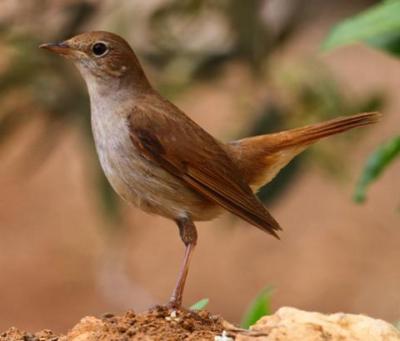 Nightingale NightingaleLuscinia
megarhynchos
Description
The nightingale is russet brown
above, dull white tinged with brown below, and
has a bright rufous tail and rump. The large,
black eyes are adorned with a white ring around
each eye. Males and females are similar in
appearance, except that males tend to be slightly
larger, with larger wingspans. Average length is
6-1/2 inches, average wingspan is 8-3/4
inches. Average weight is 0.75 ounces, but females
sometimes weigh more because males have higher
metabolic rates due to their tendency to sing.
Distribution and
Habitat
The nightingale's breeding
range extends from England through western Europe
to the Balkans and Asia Minor, and southward to
northwestern Africa. It spends its winters in
tropical Africa.
Nightingales prefer
habitats with mild to warm climates. They are
most often found in areas with dense, low thicket
growth or woodlands with young trees (preferably
hazel) and bare ground underneath.
Habits and Behaviors
This very shy bird seldom
emerges from the undergrowth when feeding and is
heard more often than seen.
Males do most of their singing
from mid-April to mid-June. While they do sing
during the day, they are most often heard at
night, hence the common name. Nightingale
songs can be divided into two categories, whistle
songs and non-whistle songs. Whistle songs are
distinct and used most often in territorial
defense and mate attraction. Males respond
aggressively to other males who may be entering
their territory. When trying to attract a female,
a male will sing for up to 50% of the night.
Older males have improved mating success due to
their larger song repertoire (180 to 260 song
variations) and territory, which attracts females
better.
Nightingales are solitary outside of the
breeding season. They are territorial, but there
are no social hierarchies.
Reproduction
The male begins displaying to
females in mid-April by spreading his tail and
rapidly moving it up and down and by fluttering
his wings with his head dipped. Up to 49%
of males may not successfully find a mate.
Nightingales are seasonally monogamous.
The bulky nest, built by the female alone, is
made of dead leaves, especially oak leaves, and
is lined with dead grass and some
hair. It is built on or slightly above the ground
among brambles and nettles or in hedges. The 4-5
olive-green or olive-brown eggs are incubated by
the female alone for 13-14 days, but both parents
work to keep the young fed. Fledging occursat
11-12 days, but the parents will continue to feed
the young for another 15-30 days.
Nightingales are sexually
mature at about a year, and can live up to 5
years.
Diet
Nightingales feed primarily on worms, spiders,
and insects (especially beetles, the larvae of
butterflies and moths, and the pupae of ants),
but will take fruits and berries in the autumn.
Most feeding is done on the ground.
Scientific
Classification
phylum Chordata
subphylum Vertebrata
class Aves
order Passeriformes
family Turdidae
genus & species Luscinia megarhynchos

Animal Diversity Web http://animaldiversity.org/accounts/Luscinia_megarhynchos/
Questions or comments about
this page?
|



